Asha Jhamandas
The Clues Are All Around
Our backyards, parks and nature trails can be great places for enjoying the outdoors, even in winter. When you are out, take a moment to notice the wildlife around you. Here are some tips:
- Look down and discover what animals are active in your area this winter. Tracks can tell you what animal passed by earlier that day or night. Tracks also offer a glimpse into the animal’s story. Experts are able to use tracks to interpret the emotional state of the animal, if it just ate a large meal and more. You can start this winter by identifying what tracks you find and noticing any patterns such as a favourite route to food or shelter.
- Watch out for tunnels in the snow. Some animal tracks might lead to tunnels in the subnivean layer — where the ground meets the snow. Small mammals such as mice, voles and shrews use this layer once the snow is deep enough to provide sufficient insulation. If you can’t find an entrance, go in your garden the next time there’s a thaw and check for the remains of these windy paths. You’ll be amazed by the intricate passages underfoot.
- Get up early, dress warmly and go owling. Each winter, many nature-loving Canadians venture out in the wee hours to make owl calls in the hopes an owl answers back. It’s thrilling to make contact in this way, although keep in mind that each time an owl flies around investigating potential threats, it expends energy needed to survive the cold. So have fun, but don’t it every night.
~ Sarah Coulber

The distance between tracks also helps narrow down the list of choices. The straddle (width between prints) and the stride (distance between steps) can give you a rough estimate of the size of the maker of the tracks. Then there is the actual print. If conditions are ideal (slightly wet, shallow snow that isn’t melting), you can measure the length and width of the print, count the number of toes, and check for claw marks. Clear, well-formed prints are rare. But with a little patience and a lot of practice, you will find it easier to interpret these winter wildlife signs.
Great horned owl

(Bubo virginianus)
If you find large tail and wing prints in snow (top), you have probably found a strike mark made by a great horned owl. Strike marks usually have a messy hole in the centre, made by the owl’s talons as it seizes prey. The feather imprints can be quite sharp if the owl had to struggle to take flight with heavy prey such as a skunk.
White-tailed deer
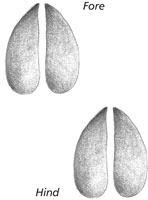
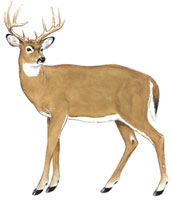

(Odocoileus virginianus)
Fore and Hind Prints:
5.1–8.9 cm long
4.1–6.4 cm wide
The size and shape of white-tailed deer prints vary, depending on sex, age, and gait. Their hoofs are cloven, so prints are often heart-shaped. Dewclaws register as small dots behind the cleave prints. Walking deer barely lift their feet off the ground, so their cleaves make parallel drag marks in the snow. Drag marks and the heart-shape are absent in prints left after a gallop. Instead, cleave marks are widely splayed.
Red squirrel
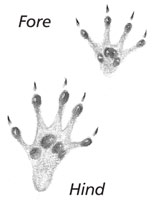
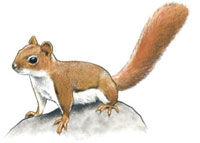

(Tamiasciurus hudsonicus)
Fore Print:
2.0–3.8 cm long
1.3–2.5 cm wide
Hind Print:
3.8–5.8 cm long
2.0–3.3 cm wide
Red squirrels always leave a hopping track that starts and ends at the bottom of a tree. Paired hind prints always fall in front of paired fore prints. Hind prints are turned slightly outward. All four prints are usually visible, but in deep snow, they may merge to form two diamondshaped prints or occasionally one large print. These snow-savvy rodents often leave behind drag marks from feet and tail.
Deer mouse
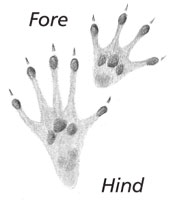


(Peromyscus maniculatus)
Fore Print:
0.6–0.8 cm long
0.6–0.8 cm wide
Hind Print:
1.5–1.6 cm long
1 cm wide
Deer mice are superb jumpers. Their trails commonly show a paired hopping pattern where hind prints always occur in front of closely paired fore prints. In soft or deep snow, the hind and fore prints on each side of the body merge to form two
longer prints. Tail drag marks are sometimes present, creating a narrow groove down the middle of the trail.
Red fox
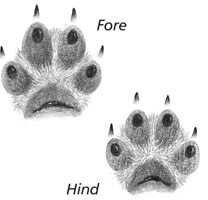
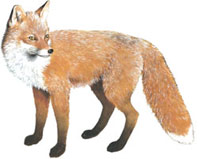

(Vulpes vulpes)
Fore Print:
5.3–7.6 cm long
4.1–5.8 cm wide
Hind Print is slightly smaller
Red fox prints show a large space between the toes and the main pads. The main pad resembles a stretched and inverted V, a shape unique to the species. The common gait is the C-shaped gallop, where the hind tracks register in front of the fore feet. The walking gait leaves a trail of open footprints in a nearly straight line.
Dark-eyed junco
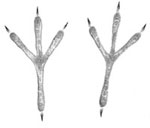

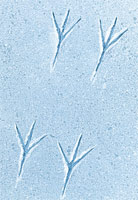
(Junco hyemalis)
Print:
3.8 cm long
The tracks of the dark-eyed junco are typical of the small hopping birds that frequent backyard bird feeders in winter. Tracks are about 4 to 13 centimetres apart and show three forward-pointing toes and a longer rear toe. In deep snow, there are toe drag marks between hops.
Raccoon
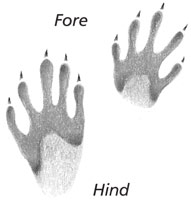
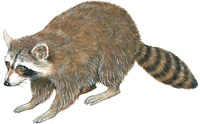

(Procyon lotor)
Fore Print:
5.1–7.6 cm long
4.6–6.4 cm wide
Hind Print:
6.1–9.7 cm long
5.1–6.4 cm wide
Raccoons have five fingerlike, bulbous toes on all feet, and their hind feet frequently leave heel marks in snow. Therefore, their tracks often resemble human handprints and footprints. Claw marks may show as small dots. Their most common gait is a rolling walk, where tracks show hind prints next to the opposite fore print. Raccoons are accomplished climbers, and their trails often lead to a tree. They den up during cold spells but come out on warmer days.
Striped skunk

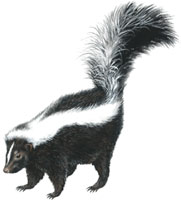

(Mephitis mephitis)
Fore Print:
3.8–5.6 cm long
2.5–3.8 cm wide
Hind Print:
6.1–9.7 cm long
5.1–6.4 cm wide
Because of their excellent defence system, skunks rarely run. Their prints are often erratically spaced but sometimes show an alternating pattern. Long digging claws on the front feet often register in tracks, and the toes point slightly inward. Like raccoons, skunks sleep for much of the winter but may wander out on warmer days.
American crow
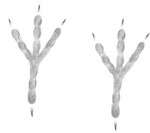
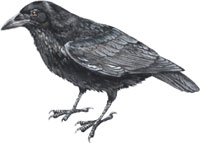

(Corvus brachyrhynchos)
Print:
6.4 to 7.6 cm long
Crows have thick, sturdy toes that point inward when they walk. When bounding forward to take off, their stride gets longer. Crows may also leave a hopping track. Their long claws have a continual tendency to close and leave long grooves in deep snow. Pads are sometimes visible on the individual toe segments.
Snowshoe hare
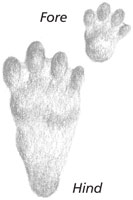
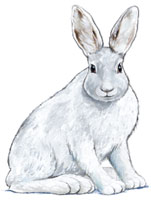
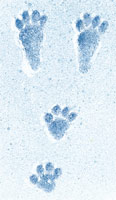
(Lepus americanus)
Fore Print:
5.1–7.6 cm long
3.8–5.1 cm wide
Hind Print:
10–15 cm long
5.1–8.9 cm wide
Snowshoe hares leave hopping tracks with groups of four prints forming a triangular pattern in snow. If a hare is bounding quickly, the distance between running groups (cluster of four prints at speed) may be as much as 130 centimetres. Snowshoe hares have thick, heavy fur on their feet, and the hind toes splay out to help distribute weight over a greater area. Hind footprints are usually much larger; however, hares walk on the toes of their hind feet, so prints made during this gait all look similar.
- 0
- 1







